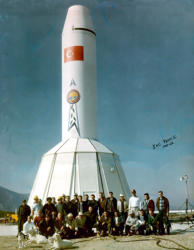
HISTORY - Page 75
were still problems to be resolved with the host nation such as siting and fabrication of some components,
and, thus, a technical or service—to—service agreement had to be concluded, it was several months before
this was accomplished, and, in the meantime, training plans had to be revised a number of times
107
.
One of the first major revisions came in February 1959, when the Secretary of Defense issued a schedule
disclosing that the first squadron would be USAF-manned and the second squadron would be manned by
the Italian Air Force (IAF). Right away, SAC proposed that entry into training for second squadron purposes
be stopped. Shortly thereafter, the 865th and 866th TTS's were deactivated. This left only one USAF
squadron—-the 864th--and this unit had completed its IWST on 24 February 1959, but had no site to deploy
to. So these personnel were entered into refresher courses, especially in areas where a lack of training
equipment had been the general condition the first time around
108
.
A change in the maintenance concept forced another major revision in early 1959. Originally, it had been
planned to have a receipt, inspection, and maintenance (RIM) area somewhat to the rear of the
emplacements, and roving mobile maintenance teams would perform cyclic and emergency maintenance.
As time went by, this did not appear to be a wise plan, for in the event of an emergency the maintenance
and repair capability needed to be on-site. Based on this, the "fire-house" concept was devised. In a sense,
the personnel now had to be both operators and maintenance technicians.
_____________________________







107. Hist of JUP Tng Pro, pp. 45-46.
108. Ibid., pp. 46-47.



Jupiter SM-78 Weapon System
I&C Team 2, Çigli AB, Turkey 1961-1962 Chrysler Corporation Missile Division

HISTORY - Page 76
were still problems to be resolved with the host nation
such as siting and fabrication of some components,
and, thus, a technical or service—to—service
agreement had to be concluded, it was several months
before this was accomplished, and, in the meantime,
training plans had to be revised a number of times
107
.
One of the first major revisions came in February 1959,
when the Secretary of Defense issued a schedule
disclosing that the first squadron would be USAF-
manned and the second squadron would be manned
by the Italian Air Force (IAF). Right away, SAC proposed
that entry into training for second squadron purposes
be stopped. Shortly thereafter, the 865th and 866th
TTS's were deactivated. This left only one USAF
squadron—-the 864th--and this unit had completed its
IWST on 24 February 1959, but had no site to deploy to.
So these personnel were entered into refresher
courses, especially in areas where a lack of training
equipment had been the general condition the first
time around
108
.
A change in the maintenance concept forced another
major revision in early 1959. Originally, it had been
planned to have a receipt, inspection, and
maintenance (RIM) area somewhat to the rear of the
emplacements, and roving mobile maintenance teams
would perform cyclic and emergency maintenance. As
time went by, this did not appear to be a wise plan, for
in the event of an emergency the maintenance and
repair capability needed to be on-site. Based on this,
the "fire-house" concept was devised. In a sense, the
personnel now had to be both operators and
maintenance technicians.
_____________________________
107. Hist of JUP Tng Pro, pp. 45-46.
108. Ibid., pp. 46-47.





















